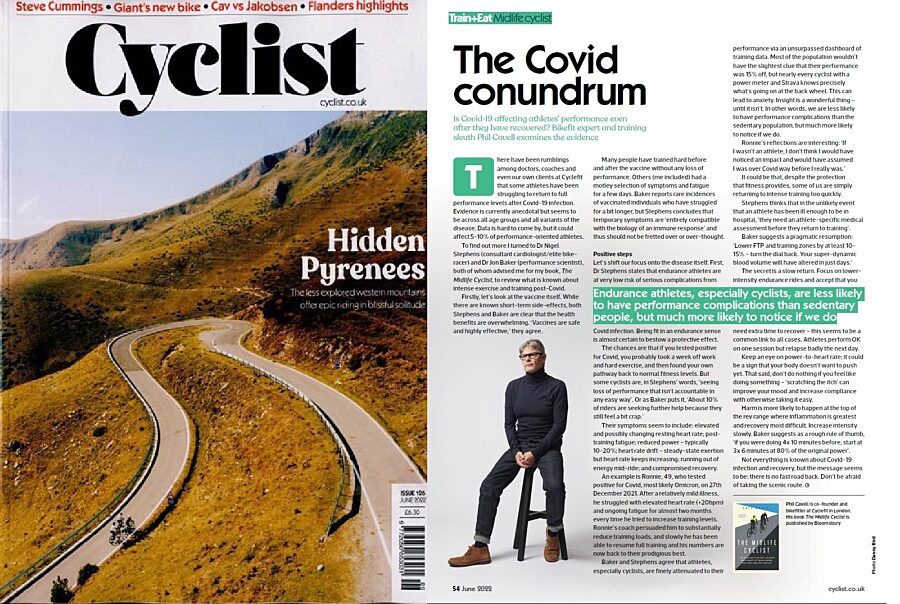"Post-covid delayed recovery could be affecting 5-10% of performance-oriented athletes at least"
The Covid Conundrum
There have been rumblings among doctors, coaches and even our own clients at Cyclefit, that some athletes have been struggling to return to full performance levels after a Covid-19 infection. Evidence is currently anecdotal but seems to be across all age groups and all variants of the
disease.
Data is hard to come by, but it could affect 5-10% of performance-oriented athletes. To find out more I turned to Dr Nigel Stephens (consultant cardiologist/elite bike-racer)
and Dr Jon Baker (performance scientist), both of whom advised me for my book, The Midlife Cyclist, to review what is known about intense exercise and training post-Covid infection.
"Covid vaccines are safe and highly effective"
Shot In The Arm
Firstly, let’s look at the vaccine itself. While there are known short-term side-effects, both Drs' Stephens and Baker are clear that the health benefits are overwhelming. ‘Vaccines are safe and highly effective,’ they agree.
Many people have trained hard before and after the vaccine without any loss of performance. Others (me included) had a
motley selection of symptoms and fatigue for a few days. Baker reports rare incidences of vaccinated individuals who have struggled for a bit longer, but Stephens concludes that
temporary symptoms are ‘entirely compatible with the biology of an immune response’ and thus should not be fretted over or over-thought
"Being fit in an endurance sense is almost certain to bestow a protective effect from Covid"
Positive steps
Let’s shift our focus onto the disease itself. First, Dr Stephens states that endurance athletes are at very low risk of serious complications from Covid infection. Being fit in an endurance sense is almost certain to bestow a protective effect. The chances are that if you tested positive for Covid, you probably took a week off work and hard exercise, and then found your own pathway back to normal fitness levels. But
some cyclists are, in Stephens’ words:
‘seeing loss of performance that isn’t accountable in any easy way’.
Or as Baker puts it,
‘About 10% of riders are seeking further help because they
still feel a bit crap.’
Their symptoms seem to include: elevated and possibly changing resting heart rate; post training fatigue; reduced power – typically 10-20%; heart rate drift – steady-state exertion but heart rate keeps increasing; running out of
energy mid-ride; and compromised recovery.
Case Study - Ronnie
An example is Ronnie, 49, who tested positive for Covid, most likely Omicron, on 27th December 2021. After a relatively mild illness, he struggled with elevated heart rate (+20bpm) and ongoing fatigue for almost two months, every time he tried to increase training levels. Ronnie’s coach persuaded him to substantially reduce training loads, and slowly he has been able to resume full training and his numbers are now back to their prodigious best.
"In other words we are less likely to have performance complications than the sedentary population, but much more likely to notice if we do."
The Rider Dashboard
Baker and Stephens agree that athletes, and especially cyclists, are finely attenuated to their performance via an unsurpassed dashboard of training data. Most of the population wouldn’t have the slightest clue that their performance was 15% off, but nearly every cyclist with a power meter and Strava knows precisely what’s going on at the back wheel. This can lead to anxiety. Insight is a wonderful thing – until it isn’t. In other words, we are less likely to have performance complications than the sedentary population, but much more likely to notice if we do.
Ronnie’s reflections are interesting: ‘If I wasn’t an athlete, I don’t think I would have noticed an impact and would have assumed I was over Covid way before I really was.’ It could be that, despite the protection that fitness provides, some of us are simply returning to intense training too quickly.
Stephens thinks that in the unlikely event that an athlete has been ill enough to be in hospital:
‘they will need an athlete-specific medical assessment before they return to training’.
Baker suggests a pragmatic resumption:
‘Lower FTP and training zones by at least 10-15% – turn the dial back. Your super-dynamic blood volume will have altered in just days.’
"Harm is more likely to happen at the top of the rev range where inflammation is greatest and recovery most difficult."
The Slow Road Back
The secret is a slow return. Focus on lower intensity endurance rides and accept that you need extra time to recover – this seems to be a common link to all cases. Athletes perform okay on one session but relapse badly the next day. Keep an eye on power-to-heart rate; it could be a sign that your body doesn’t want to push yet. That said, don’t do nothing if you feel like doing something – ‘scratching the itch’ can improve your mood and increase compliance with otherwise taking it easy. Harm is more likely to happen at the top of the rev range where inflammation is greatest and recovery most difficult. Increase intensity slowly.
Baker suggests as a rough rule of thumb -
‘if you were doing 4x 10 minutes before, start at3x 6 minutes at 80% of the original power’.
Not everything is known about Covid-19 infection and recovery, but the message seems to be: there is no fast road back. Don’t be afraid of taking the scenic route.
Phil Cavell is co-founder and bikefitter at Cyclefit in London. His book The Midlife Cyclist is published by BloomsburyThis Column was first published in Cyclist Magazine - June 2022 and is re-printed here with their kind permission.


